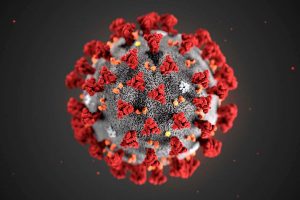COVID-19 needs no introduction, the familiar spiky ball has been tormenting us since the beginning of 2020. Consequently, researchers around the world have been working to find a vaccine and one potential solution seems rather odd. UBC researchers, led by Josef Penninger, have found that administering ACE2 decreases the virus’ infectiousness. The odd part? ACE2 is the same protein on lung cells exploited by COVID-19 to gain entry into these cells.

COVID-19 structure. The red blobs coating the virus are Spike Glycoproteins, which facilitate infection of cells. Credits: Newscientist
Infecting the lung cells…
One of main targets of COVID-19 is the lungs. This is because the surface of the lung cells are coated in ACE2 proteins. On the surface of COVID-19 there are Spike Glycoproteins, which recognize and bind ACE2 proteins, facilitating infection of the lung cells (see our previous post for general information on COVID-19). Tinkering with this ACE2 – Spike Glycoprotein interaction is the goal of many developing vaccines and was also what Penninger’s team targeted.
satisfying the virus stops the infection!
The way Penninger’s team approached this problem was truly ingenious. Since the Spike Glycoprotein binds to ACE2 on the cells, why not just administer an outside source of ACE2, so the Spike Glycoprotein can bind to those instead? The administered ACE2 would effectively bind to all the Spike Glycoproteins on the virus, rendering it inactive and unable to target cellular ACE2.
They researchers tested this theory by infecting cell cultures with COVID-19. They showed that by incubating these cultures with hrsACE2 (genetically modified ACE2), the virus growth was inhibited.
To take it a step further, the researchers grew blood vessel and kidney organoids, which are models of these respective organs. Upon administering hrsACE2, infection and spread of COVID-19 in these organoids were significantly reduced. This demonstrated that hrsACE2 could inhibit infection in human organs!

Spike Glycoproteins on COVID-19 will bind to hrsACE2 instead of cellular ACE2 – inhibiting infection. Adapted: Penninger et al. (2020)
More work is still needed
Although the results are promising, Penninger’s team caution that there are still some kinks that need to be worked out:
The inhibition [by hrsACE2] is not complete […]. This may be due to […] other co-receptors/auxiliary proteins or even other mechanisms by which viruses can enter cells.
They also suggest that future studies should look at the systems that model the lung, as this organ is the primary infection target. With all this being said, Penninger’s research is still without doubt groundbreaking, and a big push forward into getting rid of this virus once and for all.
Journal Reference
Monteil, V., Kwon, H., Prado, P., Hagelkrüys, A., Wimmer, R. A., Stahl, M., . . . Penninger, J. M. (2020). Inhibition of SARS-CoV-2 infections in engineered human tissues using clinical-grade soluble human ACE2. Cell, 181(4), 905-913.e7. doi:10.1016/j.cell.2020.04.004
